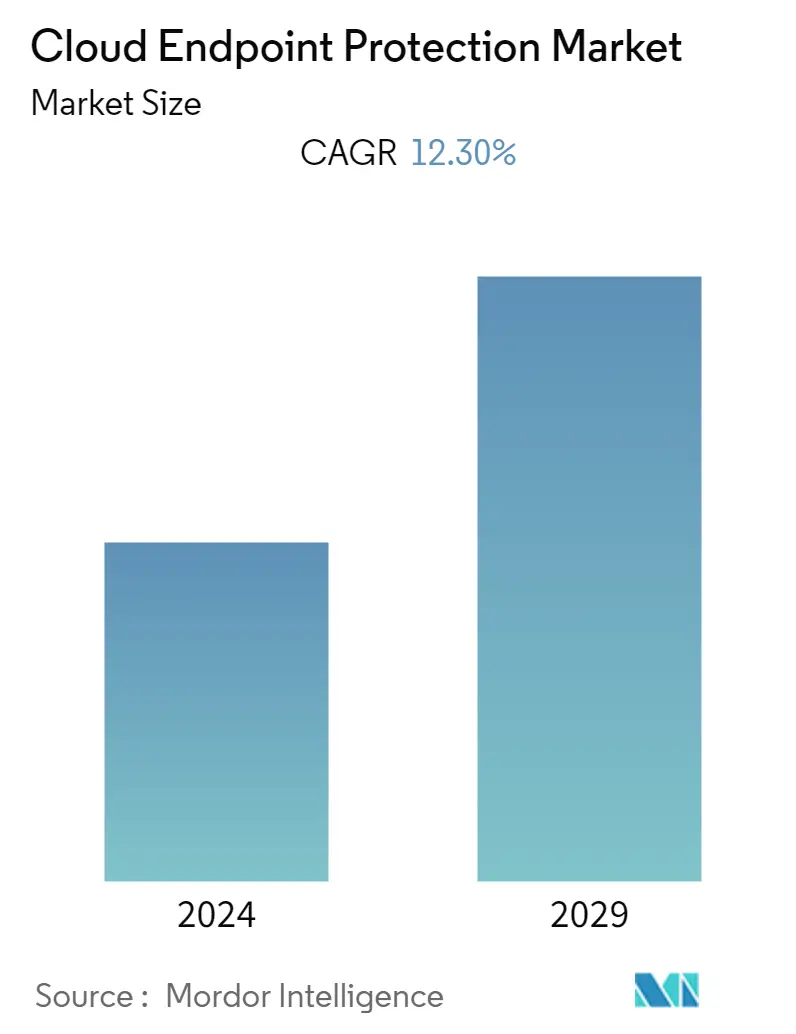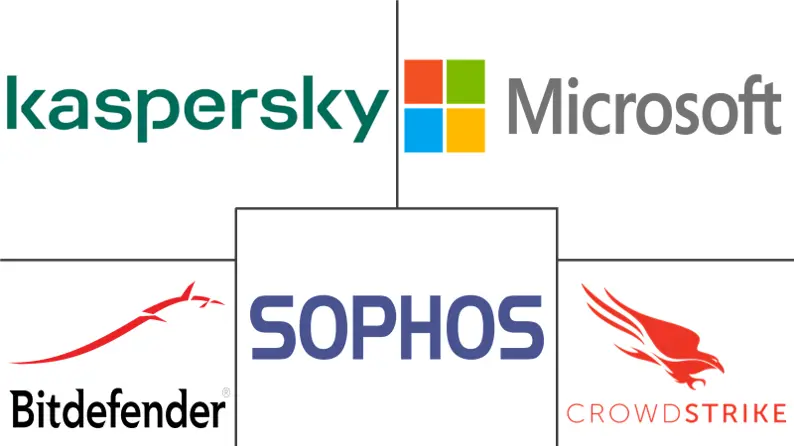Market Size of Cloud Endpoint Protection Industry

| Study Period | 2019 - 2029 |
| Base Year For Estimation | 2023 |
| CAGR | 12.30 % |
| Fastest Growing Market | Asia Pacific |
| Largest Market | North America |
| Market Concentration | Low |
Major Players
*Disclaimer: Major Players sorted in no particular order |
Cloud Endpoint Protection Market Analysis
The Cloud End-point Protection Market is expected to register a CAGR of 12.3% during the forecast period from 2021 - 2026. Cloud-based endpoint protection solutions, like traditional systems, are allowed to protect the endpoint devices and internal network security. These devices include smart devices, laptops, desktops, servers, mobile devices, and other technology connecting to the internet. It requires fewer in-house resources and has benefited over on-premise. In the case of on-premise solutions, business is entirely responsible for hosting and maintaining the software. One needs a dedicated server (or several) to organize the software and monitor the endpoints. Along with the server's actual prime cost, organizations also have to consider the costs of running and maintaining it. Cloud-based products are hosted instead on vendor's servers, eliminating the need for hiring extra staff and paying a higher electricity bill.
- The rapidly increasing connected devices, adoption of the BYOD trend, and other mobility solutions are expected to drive the adoption of cloud endpoint protection solutions even further. Bring Your Device (BYOD) has emerged as a significant trend in this new era of flexibility and network accessibility for various organizations around the world, making the workplace more productive. According to Cisco, enterprises with a BYOD policy in place saves on average USD 350 per year, per employee. Moreover, reactive programs can boost these savings to as much as USD 1,300 per year, per employee. For Small to Medium Businesses (SMBs), these cost savings can add up fast and enable these SMB's to protect their bottom line better while improving employee productivity.
- Furthermore, the increasing dependency on the connected devices has created the need to keep the connected device secure from cyber attacks. According to Ericsson, it is expected that nearly approx. With cellular connections in 2016, four hundred million IoT devices are expected to reach 1.5 billion by the year 2022. This robust growth is anticipated to be driven by the increased industry focus on the deployment of the connected ecosystem and the standardization of 3GPP cellular IoT technologies. The IoT network security segment covers various subsegments, such as firewalls, servers, VPN, IDS, IPS, WIDPS, gateway, and network hardware. According to AT&T, 47% of the organizations lack internal security, 44% have been moving to 247 security coverage, and 42% of them are looking for cost-saving strategies.
- Further, vendors redefine end-user computing by delivering an all-in-one solution for VDI, DaaS, and IoT markets, which caters to increasing endpoint security & protection needs and simplifying the user experience and allowing customers to maximize the benefits of the existing desktop hardware through PC Conversion. In June 2020, Stratodesk announced the launch of the Stratodesk NoTouch Go lightweight, thin client device. With NoTouch Go, enterprises and organizations can take advantage of unparalleled end-user computing mobility for VDI, IoT, and Cloud workspaces while also having full control and manageability over their workforce's devices. NoTouch Go runs on any endpoint, anywhere, and runs side-by-side with existing Windows installments.
- Furthermore, cyberattacks, such as phishing attacks, are on the rise during the ongoing COVID -19 pandemic. In February 2020, WHO has published a statement stating that hackers and cyber scammers are sending fraudulent email and WhatsApp messages that attempt to trick people into clicking on malicious links or opening attachments and has also mentioned not to share personal information such as usernames, passwords as well as not to click on any links posing as WHO, which tend to offer jobs, ask for registration or payment through any means. Such factors are expected to globally boost the growth of the market studied for the cloud endpoint protection market.
Cloud Endpoint Protection Industry Segmentation
Protecting against every endpoint threat is a difficult task; hence, organizations have shifted their focus to fast detection and response through a cloud endpoint detection and response (EDR) service to augment their endpoint security and protection needs. The market study comprises deployment modes, such as Private Cloud, Public Cloud, and Hybrid Cloud, providing solutions to various end-user industries, such as BFSI, government, healthcare, energy and power, and other end-user industries, along with the regions associated.
| By Enterprise Size | |
| Small & Medium Enterprises | |
| Large Enterprises |
| By Deployment Model | |
| Private Cloud | |
| Public Cloud | |
| Hybrid Cloud |
| By End-user Industry | |
| BFSI | |
| Government | |
| Healthcare | |
| Energy and Power | |
| Retail | |
| IT & Telecom | |
| Other End-user Industry |
| Geography | |
| North America | |
| Europe | |
| Asia Pacific | |
| Latin America | |
| Middle East and Africa |
Cloud Endpoint Protection Market Size Summary
The cloud endpoint protection market is experiencing significant growth, driven by the increasing number of connected devices and the adoption of mobility solutions like Bring Your Own Device (BYOD). Cloud-based endpoint protection offers advantages over traditional on-premise solutions by reducing the need for in-house resources and minimizing operational costs. This shift is particularly beneficial for small to medium businesses, allowing them to enhance security while maintaining cost efficiency. The rise in cyber threats, especially during the COVID-19 pandemic, has further accelerated the demand for these solutions, as organizations seek to protect their networks and devices from attacks such as phishing and ransomware. The healthcare sector, with its digitized records and IoT-enabled devices, is also a key area of focus, as it faces unique challenges in safeguarding sensitive data.
The market is characterized by intense competition, with numerous vendors offering diverse solutions to meet the growing demand for cloud endpoint protection. Companies are increasingly forming partnerships and focusing on product differentiation to enhance their market presence. The Asia-Pacific region, in particular, is witnessing rapid digital transformation, driven by the rise in internet users and connected devices. This region's manufacturing hub status and the increasing adoption of public cloud computing are expected to propel market growth. Innovations such as mobile endpoint integration with cloud app security and advanced security solutions for managed service providers are examples of the ongoing developments in the market. As organizations continue to migrate to cloud platforms, addressing data security and access control issues remains a priority, further fueling the demand for cloud endpoint protection solutions.
Cloud Endpoint Protection Market Size - Table of Contents
-
1. MARKET DYNAMICS
-
1.1 Market Overview
-
1.2 Industry Value Chain Analysis
-
1.3 Industry Attractiveness - Porter's Five Forces Analysis
-
1.3.1 Bargaining Power of Suppliers
-
1.3.2 Bargaining Power of Consumers
-
1.3.3 Threat of New Entrants
-
1.3.4 Threat of Substitutes
-
1.3.5 Intensity of Competitive Rivalry
-
-
1.4 Market Drivers
-
1.4.1 Growth of Smart Devices
-
1.4.2 Increasing number of Data Breaches
-
-
1.5 Market Restraints
-
1.5.1 Lack of Awareness about Cyberattacks
-
-
1.6 Assessment of Impact of Covid-19 on the Industry
-
-
2. MARKET SEGMENTATION
-
2.1 By Enterprise Size
-
2.1.1 Small & Medium Enterprises
-
2.1.2 Large Enterprises
-
-
2.2 By Deployment Model
-
2.2.1 Private Cloud
-
2.2.2 Public Cloud
-
2.2.3 Hybrid Cloud
-
-
2.3 By End-user Industry
-
2.3.1 BFSI
-
2.3.2 Government
-
2.3.3 Healthcare
-
2.3.4 Energy and Power
-
2.3.5 Retail
-
2.3.6 IT & Telecom
-
2.3.7 Other End-user Industry
-
-
2.4 Geography
-
2.4.1 North America
-
2.4.2 Europe
-
2.4.3 Asia Pacific
-
2.4.4 Latin America
-
2.4.5 Middle East and Africa
-
-
Cloud Endpoint Protection Market Size FAQs
What is the current Cloud Endpoint Protection Market size?
The Cloud Endpoint Protection Market is projected to register a CAGR of 12.30% during the forecast period (2024-2029)
Who are the key players in Cloud Endpoint Protection Market?
Microsoft Corporation, CrowdStrike Holdings, Inc., Kaspersky Lab Inc., Sophos Group PLC and Bitdefender LLC are the major companies operating in the Cloud Endpoint Protection Market.

